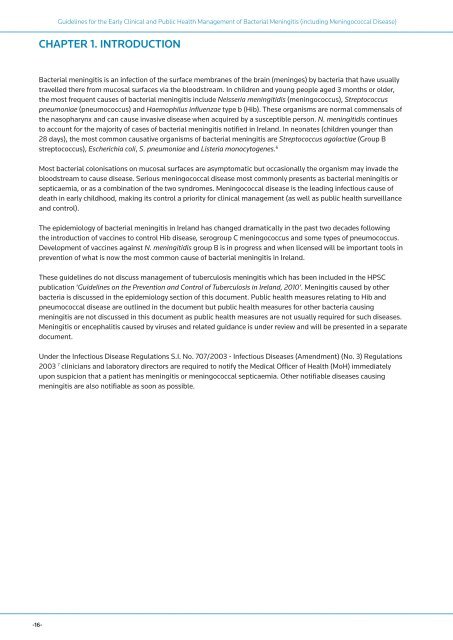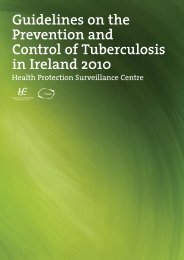Guidelines for the Early Clinical and Public Health Management of ...
Guidelines for the Early Clinical and Public Health Management of ...
Guidelines for the Early Clinical and Public Health Management of ...
Create successful ePaper yourself
Turn your PDF publications into a flip-book with our unique Google optimized e-Paper software.
<strong>Guidelines</strong> <strong>for</strong> <strong>the</strong> <strong>Early</strong> <strong>Clinical</strong> <strong>and</strong> <strong>Public</strong> <strong>Health</strong> <strong>Management</strong> <strong>of</strong> Bacterial Meningitis (including Meningococcal Disease)<br />
Chapter 1. Introduction<br />
Bacterial meningitis is an infection <strong>of</strong> <strong>the</strong> surface membranes <strong>of</strong> <strong>the</strong> brain (meninges) by bacteria that have usually<br />
travelled <strong>the</strong>re from mucosal surfaces via <strong>the</strong> bloodstream. In children <strong>and</strong> young people aged 3 months or older,<br />
<strong>the</strong> most frequent causes <strong>of</strong> bacterial meningitis include Neisseria meningitidis (meningococcus), Streptococcus<br />
pneumoniae (pneumococcus) <strong>and</strong> Haemophilus influenzae type b (Hib). These organisms are normal commensals <strong>of</strong><br />
<strong>the</strong> nasopharynx <strong>and</strong> can cause invasive disease when acquired by a susceptible person. N. meningitidis continues<br />
to account <strong>for</strong> <strong>the</strong> majority <strong>of</strong> cases <strong>of</strong> bacterial meningitis notified in Irel<strong>and</strong>. In neonates (children younger than<br />
28 days), <strong>the</strong> most common causative organisms <strong>of</strong> bacterial meningitis are Streptococcus agalactiae (Group B<br />
streptococcus), Escherichia coli, S. pneumoniae <strong>and</strong> Listeria monocytogenes. 6<br />
Most bacterial colonisations on mucosal surfaces are asymptomatic but occasionally <strong>the</strong> organism may invade <strong>the</strong><br />
bloodstream to cause disease. Serious meningococcal disease most commonly presents as bacterial meningitis or<br />
septicaemia, or as a combination <strong>of</strong> <strong>the</strong> two syndromes. Meningococcal disease is <strong>the</strong> leading infectious cause <strong>of</strong><br />
death in early childhood, making its control a priority <strong>for</strong> clinical management (as well as public health surveillance<br />
<strong>and</strong> control).<br />
The epidemiology <strong>of</strong> bacterial meningitis in Irel<strong>and</strong> has changed dramatically in <strong>the</strong> past two decades following<br />
<strong>the</strong> introduction <strong>of</strong> vaccines to control Hib disease, serogroup C meningococcus <strong>and</strong> some types <strong>of</strong> pneumococcus.<br />
Development <strong>of</strong> vaccines against N. meningitidis group B is in progress <strong>and</strong> when licensed will be important tools in<br />
prevention <strong>of</strong> what is now <strong>the</strong> most common cause <strong>of</strong> bacterial meningitis in Irel<strong>and</strong>.<br />
These guidelines do not discuss management <strong>of</strong> tuberculosis meningitis which has been included in <strong>the</strong> HPSC<br />
publication ‘<strong>Guidelines</strong> on <strong>the</strong> Prevention <strong>and</strong> Control <strong>of</strong> Tuberculosis in Irel<strong>and</strong>, 2010’. Meningitis caused by o<strong>the</strong>r<br />
bacteria is discussed in <strong>the</strong> epidemiology section <strong>of</strong> this document. <strong>Public</strong> health measures relating to Hib <strong>and</strong><br />
pneumococcal disease are outlined in <strong>the</strong> document but public health measures <strong>for</strong> o<strong>the</strong>r bacteria causing<br />
meningitis are not discussed in this document as public health measures are not usually required <strong>for</strong> such diseases.<br />
Meningitis or encephalitis caused by viruses <strong>and</strong> related guidance is under review <strong>and</strong> will be presented in a separate<br />
document.<br />
Under <strong>the</strong> Infectious Disease Regulations S.I. No. 707/2003 - Infectious Diseases (Amendment) (No. 3) Regulations<br />
2003 7 clinicians <strong>and</strong> laboratory directors are required to notify <strong>the</strong> Medical Officer <strong>of</strong> <strong>Health</strong> (MoH) immediately<br />
upon suspicion that a patient has meningitis or meningococcal septicaemia. O<strong>the</strong>r notifiable diseases causing<br />
meningitis are also notifiable as soon as possible.<br />
-16-

















